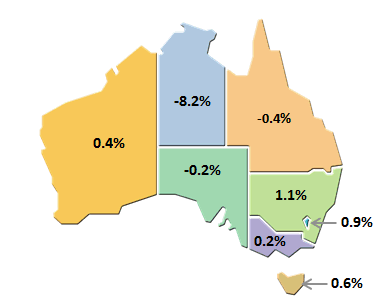MAIN FEATURES STATE FINAL DEMAND CHAIN VOLUME MEASURES
 |  | Seasonally adjusted, % change from Jun 18 to Sep 18 |
 |  | NSW | Vic. | Qld | SA | WA | Tas. | NT | ACT | Aust.(a) |
 |  |  |  |  |  |  |  |  |  |  |
|
| Final consumption expenditure |  |  |  |  |  |  |  |  |  |
 | General government | 1.8 | -0.7 | 0.3 | 2.8 | - | -0.1 | -3.6 | -0.4 | 0.5 |
 | Households | 0.2 | 0.5 | 0.5 | 0.2 | -0.1 | 0.7 | -1.0 | - | 0.3 |
| Gross fixed capital formation |  |  |  |  |  |  |  |  |  |
 | Private | 1.1 | 1.0 | -4.3 | -5.6 | 1.8 | -4.1 | -28.1 | 8.7 | -0.8 |
 | Public | 8.9 | -2.9 | 2.8 | 2.6 | 0.5 | 15.8 | 2.4 | 2.3 | 3.4 |
| State final demand | 1.1 | 0.2 | -0.4 | -0.2 | 0.4 | 0.6 | -8.2 | 0.9 | 0.3 |
|
| - nil or rounded to zero (including null cells) |
| (a) Australia estimates relate to Domestic final demand. |
SEPTEMBER QUARTER
Summary Comments
Australia
- Australian domestic final demand increased 0.3% in the September quarter 2018. Household final consumption expenditure was the largest contributor to growth. The largest detractor from growth nationally was non-dwelling gross fixed capital formation. The Northern Territory, Queensland and South Australia all experienced large falls in non-dwelling construction.
STATE FINAL DEMAND, Quarterly Volumeámeasures
: Seasonally adjusted

New South Wales
- New South Wales' state final demand increased 1.1% in the September quarter and follows a 0.5% increase in the June quarter. Public final demand drove growth in New South Wales with increases in public capital formation, which reflects ongoing strength in state and local general government infrastructure investment. Government final consumption expenditure also contributed to growth. Private final demand contributed to growth with rises in household final consumption expenditure and private investment.
Victoria
- Victoria's state final demand increased 0.2% in the September quarter driven by the private sector. Household final consumption expenditure was the strongest contributor to growth recording a rise of 0.5%, above the national growth of 0.3%. Private gross fixed capital formation also contributed to growth, driven by non-dwelling construction. Government expenditure and investment both detracted from growth, driven by state and local government which came off a strong increase in the June quarter 2018.
Queensland
- Queensland's state final demand decreased 0.4% in the September quarter following a 0.5% increase in the June quarter. Private investment drove the fall in state final demand, driven by non-dwelling construction and machinery and equipment investment. This decline was partially offset by growth in household final consumption expenditure and public final demand.
South Australia
- South Australia's state final demand decreased 0.2% in the September quarter following a 1.2% increase in the June quarter. The fall was driven by weakness in private investment due to a large decrease in non-dwelling construction. The decrease followed a large rise in the June quarter 2018. Government final consumption expenditure increased strongly and partially offset the fall in private capital formation. Household final consumption expenditure and public investment both increased modestly this quarter.
Western Australia
- Western Australia's state final demand increased 0.4% in the September quarter and follows a revised 0.4% decrease in the June quarter. Private investment drove the rise in the September quarter with machinery and equipment investment the largest contributor to growth. Public investment also contributed to growth driven by public corporations. Falls in household final consumption expenditure partially offset growth in investment resulting in a slight increase in state final demand. Government final consumption expenditure remained unchanged and did not contribute to growth.
Tasmania
- Tasmania's state final demand increased 0.6% in the September quarter and follows a 0.9% increase in the June quarter. Public gross fixed capital formation drove growth in September quarter driven by the general government sector. Household final consumption expenditure also contributed strongly to growth. Conversely, private investment fell in the September quarter due to reduced investment in machinery and equipment. Government expenditure also fell, detracting slightly from growth in state final demand.
Northern Territory
- Northern Territory's state final demand decreased 8.2% in the September quarter and follows a 2.0% decrease in the June quarter. As in the June quarter, the largest detractor from growth was private investment driven by non-dwelling construction. Both government and household final consumption expenditure decreased in the September quarter. Public investment rose due to increased investment from the general government sector.
Australian Capital Territory
- Australian Capital Territory's state final demand increased 0.9% in the September quarter and follows a 2.4% increase in the June quarter. Private capital formation drove growth in the September quarter due to non-dwelling construction and dwellings. The rise was supported by an increase in public capital formation. Growth in household expenditure was flat for the quarter. Government final consumption expenditure decreased, detracting from growth.
 Quality Declaration
Quality Declaration  Print Page
Print Page
 Print All
Print All